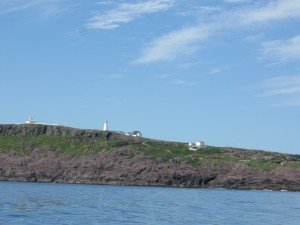
One feels like a chump, almost, motoring through a calm with storm canvas up, but it had seemed prudent, given the sudden winds that habitually come off of every inlet and around every cape along the Avalon Peninsula. It proved uneccesary that day, as indeed any sails on that day were superfluous—the Atlantic was calm as a millpond, with only occasional cat’s paws playing across the surface. We let the girls sit on the foredeck to enjoy the pageant of whales, puffins and gannets that swarmed the air and water, especially around Witless Bay and Cape Spear, which is the eastermost point of land in America.

St John’s, our destination, is an incredibly bustling commercial harbor, with giant oil rig tenders coming and going at all hours, while cruise ships and containers add their share to the fun. We had no guidebook for Newfoundland yet, just a notion that there was a yacht club somewhere. A jog around the harbor, which is pretty small considering all the activity, revealed no yacht club, nor even a solitary sailboat mast. The only remote possibility, short of jostling in to the commercial bulkheads between a Russian cruise ship and an arctic crabber, were two floating piers at what appeared to be a public park, so we decided to check them out. We wouldn’t have thought there was depth there, except that the gargantuan bows of an oil tender, drawing more than 20 feet, hung practically over the park. It turned out they were the only possible spot to tie up in St John’s, since the St. John’s yacht club isn’t there at all—it’s thirty miles away around Cape Francis in Conception Bay. A far pleasanter spot for a yacht club, no doubt, but misleading to poor wayfaring foreigners.

No matter: it seems we landed on our feet with those piers. After the customs guys came down to welcome us back to Canada (That we’d been back for a couple of weeks since arriving in Trepassey from St Pierre didn’t make any difference: we weren’t officially back until they could greet us and ask whether we needed anything—anything at all! The world would be a nicer place if all customs officials were as nice as Canadian ones are) we were free to stretch our legs. The grocery store was a bit far away, but seeing the best selection of fresh vegetables and meat since leaving the ‘States made up for that, and finding a laundromat on the way was just the cherry on top.

Summer finally arrived while we were there—for three days, while we did laundry, stocked up on groceries and hiked a splendid, blueberry-laced trail along the hills by the harbor, the temperature went to almost ninety. No matter that less than a week after the record-setting day we were back in wool sweaters, shivering in a blustery norther—for two nights we hadn’t even thought of putting jackets on, even after dark.
 We would gladly have stayed in St John’s longer—it’s one of the oldest cities in America, just awash in history: churches, courthouses, forts and historic sites. We saw only a tiny slice of what the city has to offer, but we have a lot of sea miles to go if we’re to get around and back to lower latitudes before fall thinks of arriving. Looking at some of the charts we bought while there disclosed that Newfoundland, with all it’s deep bays and archipelagos, has far more cruising than you could do in many summers. Besides, in spite of being sheltered and secure, St. John’s was frightfully noisy whenever a ship passed by, which they do almost constantly, even in the wee hours. So it was less than a week after arriving that we cast the lines off, pushed Ganymede backwards out of her slip, and hoisted the sails.
We would gladly have stayed in St John’s longer—it’s one of the oldest cities in America, just awash in history: churches, courthouses, forts and historic sites. We saw only a tiny slice of what the city has to offer, but we have a lot of sea miles to go if we’re to get around and back to lower latitudes before fall thinks of arriving. Looking at some of the charts we bought while there disclosed that Newfoundland, with all it’s deep bays and archipelagos, has far more cruising than you could do in many summers. Besides, in spite of being sheltered and secure, St. John’s was frightfully noisy whenever a ship passed by, which they do almost constantly, even in the wee hours. So it was less than a week after arriving that we cast the lines off, pushed Ganymede backwards out of her slip, and hoisted the sails.

It’s a strange feeling—for almost four years since leaving California our general trend has ever been to the East—whether south-along the coast of Central America to the Panama Canal, or north again toward Rhode Island, Nova Scotia and Newfoundland, the compass card has usually been in the eastern quadrant. Now we’ve left our easternmost point behind, to return West, though it be North also for a spell yet. Not unless we somehow, years from now, make another plan to cross the Atlantic, will we sail so far in this direction. It may be that we never make it this far east again, but it’s a rare treat to have done so, and the easternmost city in America is a fine place to have been.